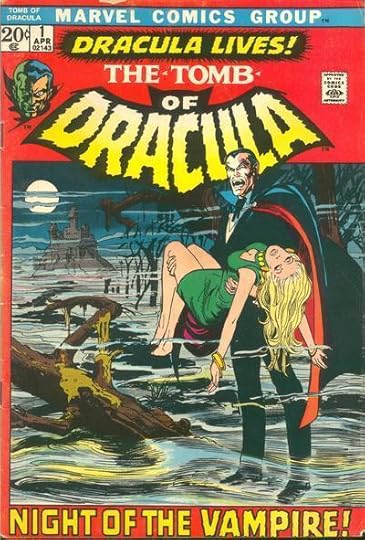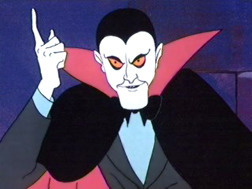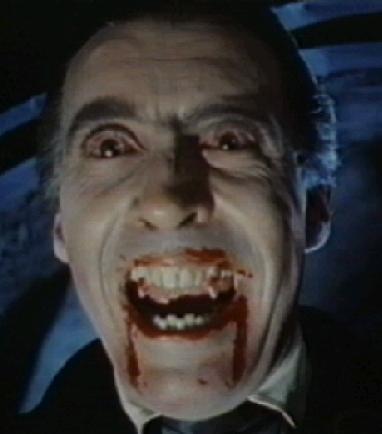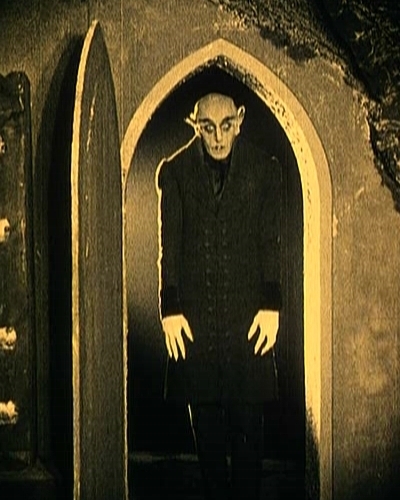My Favorite Vampires
Book Chick City in the UK was nice enough to ask me to do a guest post for its Halloween month-long celebration. You can see it here, or you can take a look at the version with links below. If you're at all interested in what warped me as a child, this is everything you could want to know.
I never liked vampires as a kid. Still don't, even though telling stories about them now pays my mortgage. Vampires, you see, are frightening. They're not tortured souls, they're no
t romantic, and they're certainly not cute. They are fang-faced, blood-drinking monsters.
So, despite my antipathy toward vampires, I made it a practice to learn everything I could about them. It's a quest that continues today, and I'm willing to share what I know with you.
Be warned: these vampires don't sparkle. You turn your back on them for a minute, you're lunch. Good luck.
10. The Great Skull Island Vampire, from the Scooby Doo Show (1977)
Laugh all you want, but
this guy was the source of the first nightmare I can remember, and his influence sparked my lifelong fear and fascination with vampires.
Dog detective Scooby and his hapless human friends are at yet another haunted location, where they're enlisted to help their friend Lisa break the family curse that threatens to turn her into a vampire. (Seriously, Scooby and the gang got invited to the worst parties.)
I never really bought Velma's rational, scientific explanation that proved the vampire was actually sleazy Uncle Leon. It didn't matter that he was the only other cast member, and therefore the only reasonable suspect. Even at six years old, I knew the vampire was still out there, waiting in the dark.

9. Marvel Comics' version of Dracula, from Tomb of Dracula. (1972-1979)
The Seventies were a great time for horror, and comic book companies raced to cash in on the resurrected interest in the undead. The best effort was Marvel Comics' Tomb of Dracula, a book which had the unenviable task of making the Lord of the Vampires sympathetic enough to keep little snots like me interested, but not so sympathetic that we wouldn't cheer for the heroes trying to stake him through the heart.
Writer Marv Wolfman (a comics legend who also has one of the best names any author could ask for) managed to pull off this trick by consistently putting Dracula up against even greater evils, like, say, Satan. One panel that's still vivid in my memory is Dracula actually holding a cross, hands burning, as he defends children who were kind to him against a mindless group of zombie-like vampires. Sure, he was protecting himself as well, having lost his vampiric powers, but this might have been the first time I had the spark of an idea that a vampire could do good instead of evil.
Most of the time, however, Dracula was a complete bastard. And though I would have sworn otherwise at the time, I found myself rooting for him.
8. The vampire teenagers of The Lost Boys (1987)
7. The redneck vampires of Near Dark (1987)
Vampires fell out of favor for a while, dispelled by the bright shiny rays of Ronald Reagan's Morning in America. Despite movies like The Hunger (1983), vampires became something of a joke, with Love at First Bite (1979), Once Bitten (1985) Transylvania 6-5000 (1985), and, to an extent, Fright Night (1985) playing the vampire mythos for laughs.
The Lost Boys and Near Dark brought the screams back. The Lost Boys were a slick, hair-gelled, leather-jacketed clique welcoming the new kid in town. The only downside to becoming one of the cool kids – losing your humanity and trying to feed on your annoying kid brother. On the plus side, you got to sleep with Jami Gertz, who was sort of the apotheosis of Eighties Hot Girl.
Near Dark, on the other hand, was truly frightening. Long before she won an Oscar for The Hurt Locker, Kathryn Bigelow directed a story about a traveling clan of redneck bloodsuckers who could turn a bar full of shit-kickers into snack-packs in a matter of minutes. Atmospheric, moody and tense, there was no winking or laughing at vampire tropes here. Near Dark, unlike The Lost Boys, forced audiences to face the horror without turning away to one-liners or irony.
But both movies made it clear: fangs were for tearing out throats – not gentle love-bites and definitely not for giggles.
6. Blacula, from Blacula (1972)
There's not a lot to say about Blacula, except he's a hybrid of Dracula and Shaft. If you can't see how badass that is, I don't think there's anything I can say to make it clearer.
5. Angel, from "Buffy The Vampire Slayer" and "Angel" (1997)
There have been many, many attempts to make a vampire a good guy, but only Joss Whedon really captured the torment that would have to be involved in this dichotomy. Vampires are, by their nature, evil. They take joy in the pain of others, and willfully cause suffering to survive. Angel, on the other hand, was cursed with a human soul after chomping the wrong neck, and a couple centuries' worth of good times became a massive, crushing load of guilt.
While his solo series had its ups and downs, it became more sophisticated than Buffy in how it faced the nature of evil. Angel never got to take a vacation, and there was no happy ending. He simply fought the darkness all the time. It might have been a losing battle, but it was the only one worth fighting.
4. Joe Pitt, from the Joe Pitt Casebooks by Charlie Huston (2005-2009)
Joe Pitt is not a teen dream by any stretch of the imagination. Turned as a punk kid in the Seventies, Pitt has tried to work within vampire society in the confines of New York, but just cannot handle authority. As a result, he's beaten, stabbed, shot, starved, threatened, broken, and banished to the sewers. Through it all, he survives. He has the instincts of a cockroach, and as low as his enemies go, he can always sink lower.
And yet, he's actually one of the few fictional vampires whose moral code is simple, honest and believable. He's fiercely loyal to the woman he loves, and he's willing to kill anyone who'd threaten her. Actually, he's willing to kill everyone, just in case they might threaten her.
3. Hammer Horror's Dracula, as played by Christopher Lee (1958)
I was lucky enough to grow up in a town with an independent TV station. Before it became a Fox affiliate, it had hours and hours of time to fill. This meant every October was stuffed with cheap horror flicks in a 31-day Halloween marathon. And that's how I saw almost all the Hammer Horror movies of Dracula before I was 13. As much as I appreciate Bela Lugosi's portrayal of Dracula, Christopher Lee will always be the only true count for me. Seriously, the guy was simply terrifying, and seemingly unstoppable. He "died" in epic battle with Van Helsing – much better than even Stoker's original ending, he said blasphemously – but returned for the inevitable sequels.
2. The Night Flier, from the short story by Stephen King (1988)
Stephen King is a great writer. I honestly think The Stand is a contender as one of the great American novels. Give him pages and time, and he can create entire worlds for a reader. But his short works, like The Night Flier, are like hits off a crack pipe – addictive and lethal. The title character is a murderer who flies from one small airport to the next in a black Cessna, killing everyone he finds. He's tracked by a reporter who discovers the killer is an actual vampire, the rear of his aircraft filled with soil and turned into a mobile coffin. King takes the old, familiar vampire lore – the stuff that could seem faintly ridiculous – and makes it bladder-voiding scary. He'd do the same with Kurt Barlow in 'Salem's Lot, but to me, the Night Flier was always the creature of purer menace.
1. Count Orlok, from Nosferatu (1922)
It shouldn't be as scary as it is. It's a silent film, made with primitive filming techniques and special effects. It's not even a licensed production of Dracula, for Christ's sake. Bram Stoker's widow had to sue the filmmakers for ripping off her husband's work. But it is proceeds with the sleepwalking logic of a bad dream that just won't end. Max Schreck is possibly the only actor to ever be accused in urban legends of being an actual vampire based on his performance. While the movie is still a product of its age, any moment that Schreck is onscreen is eerie, disturbing, and filled with dread. Nosferatu shows us what a real vampire looks like, and its DNA is encoded in the blood of every worthy contender to the title since.














